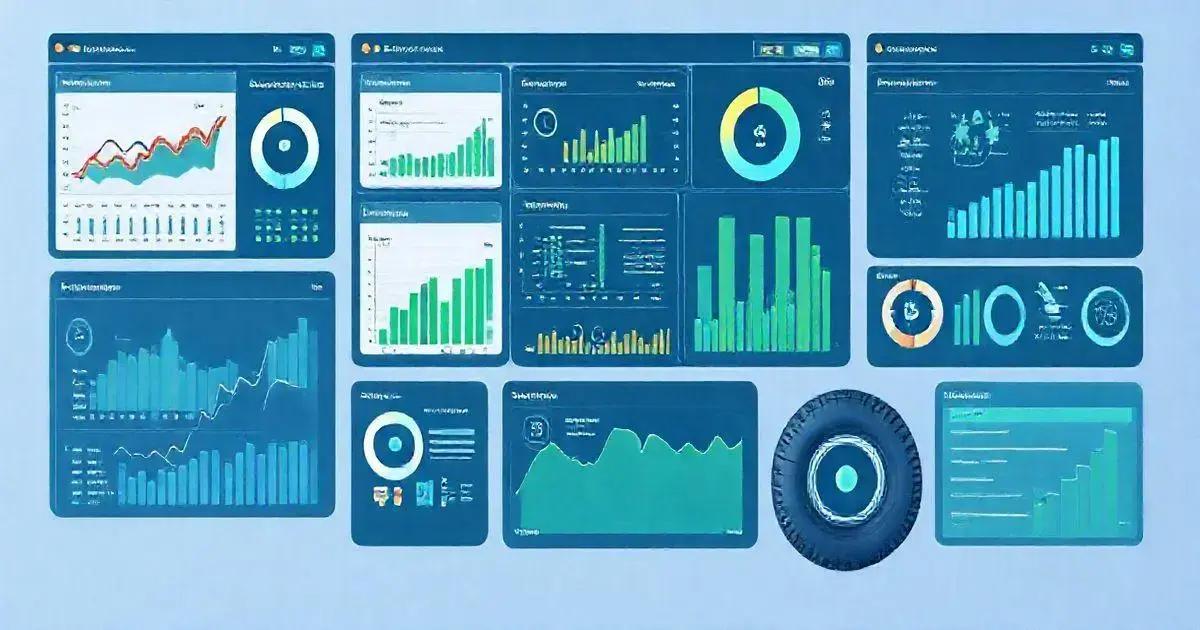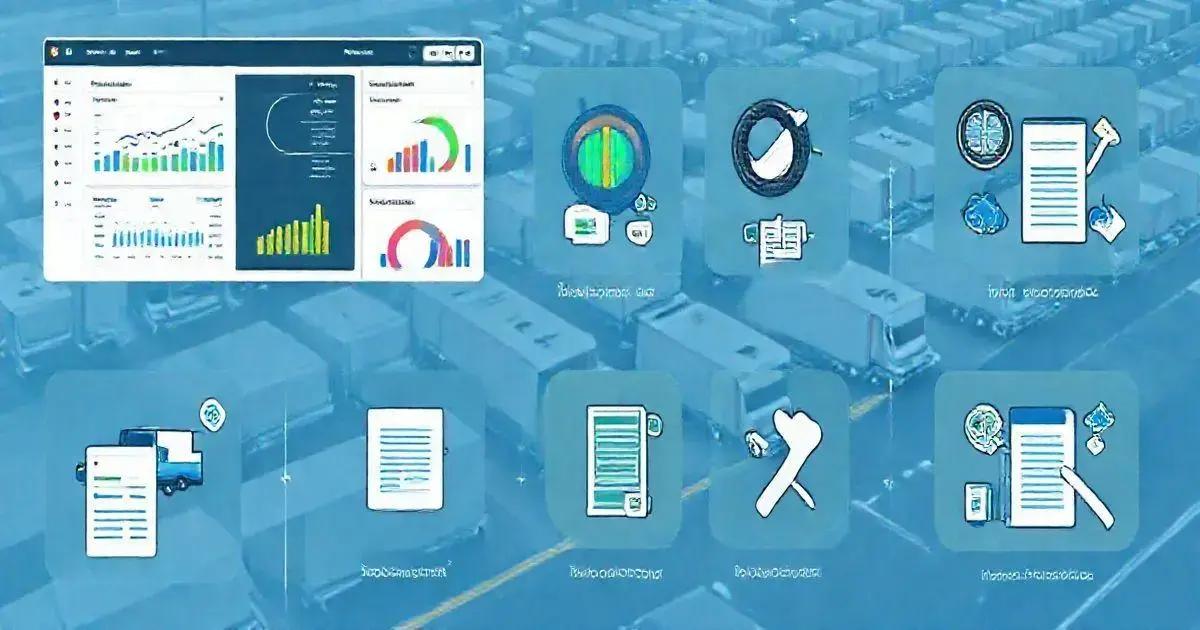10 Reasons to Use Fleet Control Worksheet 7.0 Today! Leave a comment
The Fleet Control Worksheet 7.0 is a comprehensive fleet management tool that includes features for dashboard insights, travel and cargo control, maintenance tracking, tire management, and cost analysis, all aimed at improving efficiency, safety, and cost-effectiveness in fleet operations.
The Fleet Control Worksheet 7.0 is a powerful tool designed to help businesses manage their fleets more efficiently. With features like initial dashboards, travel and cargo control, tire management, and maintenance tracking, this worksheet offers comprehensive solutions for fleet management.
In this article, we will explore the benefits of using the Fleet Control Worksheet 7.0 and how it can optimize your operations.
Key Features of Fleet Control Worksheet 7.0
The Fleet Control Worksheet 7.0 is packed with features that make fleet management simpler and more efficient. Here’s a breakdown of some of the key functionalities:
Key Features of Fleet Control Worksheet 7.0
- Dashboard Overview: The initial dashboard provides a quick glance at critical metrics such as kilometers driven per vehicle, average fuel consumption, and maintenance costs. It allows managers to spot trends and address issues before they escalate.
- Travel and Cargo Control: This worksheet efficiently tracks all trips, including cargo details, vehicle allocation, and driver information. It helps ensure that deliveries are made on time and that vehicles are used optimally.
- Maintenance Tracking: Regular maintenance is essential for fleet longevity. The worksheet includes a module to schedule and track preventive and corrective maintenance, helping to minimize downtime and extend vehicle life.
- Tire Management: Tire control features include tracking tire life, scheduling replacements, and maintaining records of tire changes. This ensures safety and optimal vehicle performance.
- Cost Analysis: The worksheet offers detailed cost analysis, including fuel, maintenance, and operational expenses. This feature helps businesses make informed decisions based on accurate financial insights.
- Customizable Reports: Users can generate customizable reports for specific periods or vehicles, allowing for tailored insights into fleet performance and expenses.
With all these features, the Fleet Control Worksheet 7.0 stands out as an invaluable resource for any business looking to streamline its fleet management processes.

Initial Dashboard Overview
The Initial Dashboard of the Fleet Control Worksheet 7.0 serves as the central hub for monitoring your fleet’s performance at a glance. It is designed to provide essential insights quickly and efficiently, helping fleet managers make informed decisions. Here’s what you can expect from the dashboard:
Dashboard Features
- Key Performance Indicators (KPIs): The dashboard displays vital KPIs such as total kilometers driven, average fuel consumption per vehicle, and maintenance costs, allowing you to assess your fleet’s efficiency immediately.
- Visualizations: With easy-to-read graphs and charts, the dashboard presents data visually, making it simpler to identify trends over time. For example, you can quickly see the correlation between fuel consumption and maintenance schedules.
- Real-Time Updates: Data is updated regularly to reflect real-time performance metrics, ensuring that you have the most accurate information at your fingertips.
- Alerts and Notifications: The dashboard can highlight alerts such as overdue maintenance tasks or unusually high fuel consumption, prompting timely actions to resolve issues.
- Customizability: Users can customize the dashboard to prioritize the metrics that matter most to their operations, ensuring that the most relevant data is front and center.
This Initial Dashboard Overview not only simplifies fleet management but also enhances decision-making by providing crucial data in a user-friendly format. By leveraging these insights, you can optimize fleet operations, reduce costs, and improve overall efficiency.
Travel and Cargo Control
The Travel and Cargo Control feature of the Fleet Control Worksheet 7.0 is essential for managing the logistics and efficiency of your fleet. This section allows fleet managers to meticulously track each journey, ensuring that all cargo is accounted for and handled properly. Here’s a closer look at what this feature offers:
Key Features
- Trip Scheduling: Users can schedule trips with detailed information, including the date, time, routes, and assigned vehicles. This helps in planning and optimizing vehicle usage across different deliveries.
- Cargo Details: Each trip entry includes specific information about the cargo, such as type, weight, and dimensions. This facilitates better load management and compliance with transport regulations.
- Driver Assignment: The worksheet allows for easy assignment of drivers to each trip, maintaining a clear record of who is responsible for what cargo. This helps streamline communication and accountability among the team.
- Expense Tracking: For each trip, associated costs can be tracked, including fuel expenses, tolls, and other fees. This assists in providing accurate budget assessments and identifying cost-saving opportunities.
- Real-Time Updates: Fleet managers can update trip statuses in real-time, providing visibility on delays, completed deliveries, or changes in routes. This real-time information is crucial for responding to unexpected challenges.
- Historical Data Analysis: The travel records are stored for ongoing analysis, allowing users to track performance over time, identify trends, and make necessary adjustments to improve efficiency in future operations.
The Travel and Cargo Control feature is integral in ensuring that fleet operations run smoothly and that all logistical aspects are effectively managed. By utilizing this feature, companies can enhance their overall productivity and customer satisfaction through timely deliveries and accurate tracking of cargo.
![]()
Maintenance Tracking and Management
The Maintenance Tracking and Management feature of the Fleet Control Worksheet 7.0 plays a crucial role in ensuring that your fleet remains in top condition. This feature helps businesses minimize downtime, extend vehicle life, and reduce repair costs through systematic tracking and management of maintenance activities. Here’s a detailed overview:
Maintenance Tracking and Management
- Scheduled Maintenance: Users can set up a schedule for regular maintenance tasks, such as oil changes, tire rotations, and brake inspections. This proactive approach helps prevent major breakdowns and costly repairs.
- Record Keeping: Every maintenance activity can be logged, detailing the date, type of service performed, costs involved, and the service provider. This comprehensive record provides valuable insights into vehicle health and service history.
- Alerts and Reminders: The worksheet can generate alerts to remind users of upcoming maintenance due dates, ensuring that no service is missed. This is vital for keeping vehicles compliant with safety regulations and operational standards.
- Cost Analysis: By tracking maintenance expenses, users can analyze the total cost of ownership for each vehicle. This data helps in identifying trends and determining whether certain vehicles require more frequent or costly maintenance than others.
- Performance Metrics: Users can assess metrics such as average maintenance costs, frequency of repairs, and time between services. These insights guide decisions on whether to retain, repair, or replace vehicles based on their performance.
- Integration with Other Features: The maintenance tracking feature seamlessly integrates with the Travel and Cargo Control functions, allowing for comprehensive analysis of how maintenance impacts vehicle performance across trips.
By effectively utilizing the Maintenance Tracking and Management feature, businesses can enhance fleet reliability, ensure safety, and improve overall operational efficiency. It empowers fleet managers to make informed decisions regarding vehicle maintenance and investment, ultimately saving time and costs in the long run.
Tire Control Management
The Tire Control Management feature of the Fleet Control Worksheet 7.0 is vital for maintaining the safety and efficiency of your fleet. Proper tire management ensures optimal vehicle performance and reduces the risk of accidents caused by tire failure. Here’s an overview of the capabilities this feature provides:
Tire Control Management
- Tire Inventory Tracking: Users can maintain an inventory of all tires assigned to vehicles in the fleet. This includes details such as tire types, sizes, and purchase dates, ensuring that all assets are accounted for.
- Maintenance Scheduling: The worksheet allows users to schedule regular tire maintenance activities, such as rotations and alignments, which are essential for extending tire lifespan and maintaining vehicle handling.
- Replacement Planning: By tracking tire wear and age, users can predict when tires will need replacement. This feature helps prevent unexpected failures and allows for planning budgetary needs for new tires.
- Tire Performance Metrics: The worksheet includes metrics to analyze tire performance, such as average mileage before wear, fuel efficiency impacts, and maintenance costs associated with each tire. This data assists in making informed purchasing decisions.
- Alerts for Tire Changes: Users receive alerts when tires are due for rotation or replacement based on mileage or time intervals, ensuring proactive management of tire conditions.
- Action Status Tracking: The feature allows users to track the status of each tire, including allocations to vehicles and any actions taken, such as repairs or replacements. This visibility is crucial for effective fleet management.
Utilizing the Tire Control Management feature not only enhances fleet safety but also helps in optimizing costs related to tire purchases and maintenance. By keeping detailed records and proactively managing tire conditions, fleet managers can ensure that vehicles operate efficiently and safely on the road.

Cost Analysis and Reporting
The Cost Analysis and Reporting feature of the Fleet Control Worksheet 7.0 is designed to provide fleet managers with a comprehensive understanding of the financial aspects of their operations. By analyzing costs effectively, businesses can identify areas for improvement and make informed decisions. Here’s a closer look at what this feature offers:
Cost Analysis and Reporting
- Detailed Expense Tracking: Users can log all expenses associated with fleet operations, including fuel costs, maintenance expenses, insurance, and any other operational costs. This detailed tracking allows for a holistic view of total expenditures.
- Cost Categorization: The worksheet enables users to categorize costs into various segments, such as fuel, maintenance, tires, and repairs. This categorization helps in pinpointing specific areas where costs may be higher than expected.
- Comparative Analysis: Users can compare costs across different vehicles or periods to identify patterns or discrepancies. For example, if one vehicle is consistently more expensive to maintain, it may warrant further investigation.
- Custom Reports: The feature allows users to generate customized reports that summarize expenses by category, vehicle, or timeframe. These reports can be useful for presentations to stakeholders, budgeting processes, or strategic planning.
- Budget Forecasting: With historical data at their disposal, fleet managers can forecast future costs based on trends. This helps in budget preparation and financial planning, ensuring that sufficient resources are allocated to maintain fleet operations.
- Visual Insights: The cost analysis function includes charts and graphs that visually represent spending, making it easier to understand financial data at a glance. Visual insights can highlight significant costs and facilitate discussions about cost-saving strategies.
By leveraging the Cost Analysis and Reporting feature, fleet managers can optimize their spending, enhance financial accountability, and develop strategies to reduce costs effectively. This capability not only contributes to better fleet management but also helps in maximizing overall profitability for the business.
Conclusion
In conclusion, the Fleet Control Worksheet 7.0 is an indispensable tool for businesses looking to streamline their fleet management processes.
With its comprehensive features, including travel and cargo control, maintenance tracking, tire management, and cost analysis, this worksheet empowers fleet managers to enhance efficiency and productivity.
By utilizing the Initial Dashboard for quick insights, tracking travel and cargo meticulously, managing maintenance schedules effectively, and analyzing costs accurately, businesses can make informed decisions that lead to significant cost savings and improved operational performance.
Ultimately, adopting the Fleet Control Worksheet 7.0 not only improves the management of vehicles and resources but also ensures that your fleet operates safely and efficiently, paving the way for sustainable growth and success in the industry.
FAQ – Frequently Asked Questions about Fleet Control Worksheet 7.0
What is the Fleet Control Worksheet 7.0?
The Fleet Control Worksheet 7.0 is a comprehensive tool designed to help businesses manage their fleet operations efficiently, including features for travel control, maintenance tracking, tire management, and cost analysis.
How can I track maintenance schedules with this worksheet?
You can set up a schedule for regular maintenance tasks, log maintenance activities, and receive alerts for upcoming services to ensure your vehicles remain in top condition.
Can I customize the reports generated by the worksheet?
Yes, the worksheet allows for customizable reports, enabling users to summarize expenses by category, vehicle, or timeframe, tailored to specific business needs.
Is there support available if I encounter issues with the worksheet?
Yes, technical assistance is provided from Monday to Friday, and you can reach out via email or WhatsApp for support with any issues.
Does the worksheet include tire management features?
Absolutely! The Tire Control Management feature allows you to track tire inventory, schedule maintenance, and monitor tire performance to ensure safety and efficiency.
Can I use this worksheet across multiple computers?
Yes, you can install and use the Fleet Control Worksheet 7.0 on multiple computers without any additional fees after the initial purchase.

